Signal polygon: Difference between revisions
| Line 79: | Line 79: | ||
<br> | <br> | ||
The distance between the two surfaces is determined by the value of the "Spacing between single signals", see default entry in the "Check project" dialog. Unless the individual entry for the "Minimum track spacing" of the | The distance between the two surfaces is determined by the value of the "Spacing between single signals", see default entry in the "Check project" dialog. Unless the individual entry for the "Minimum track spacing" of one of the signals (or their signal classes) would be set larger. Then this value would be used. So the higher value of both will be used to determine the gap.<br><br> | ||
== Adjust auras == | == Adjust auras == | ||
Revision as of 18:06, 12 June 2018
From version V19!
![]()
Icon to be found in the layout view among the drawing functions
General
Any filled polygon on a copper layer can be furnished with a signal. Each can be handled like a separate ground plane. It can individually be furnished with attributes. On one copper layer any number of polygons with different signals can be drawn.
You can reach this mode:
- by keyboard key [6],
- by menu item "6 Draw ground polygon" in menu "Elements"
- by icon
 among the drawing functions
among the drawing functions 
Old polygons found
If you open a project which had been created by a version V18 or older, the following dialog will appear:
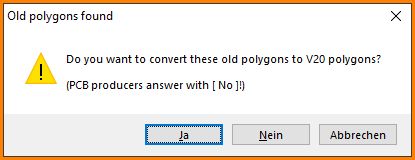
Image: The dialog "Old polygons found"
What's behind it?
If you have created a project with a version V18 or older, the conversion of polygons might cause minor changes to the polygon surfaces (roundings, etc). The printed circuit board would then look slightly different than it appeared earlier. Therefore, PCB manufacturers should not carry out the conversion. However, the normal user should convert old polygons to new ones. The new polygons are easier to handle and more flexible than the old ones. It is preferable to compute the new polygon filling at the end of the design process and leave it in a primitive state, see the option "Compute filling" at the bottom of the following dialog. Then one can fade in/out each of the layers involved separately ("copper", "deletion", and "area") the same as in earlier versions. The functions "Check project" as well as the creation of Gerber data will fill the areas later anyway.
What you can do
Define the corners of the polygon by M1. You can close the polygon automatically by [Return] when drawing the last segment. M2 does the same so that you end the line exactly an the starting point of the polygon. Immediately the dialog for edition of the signal polygon opens.
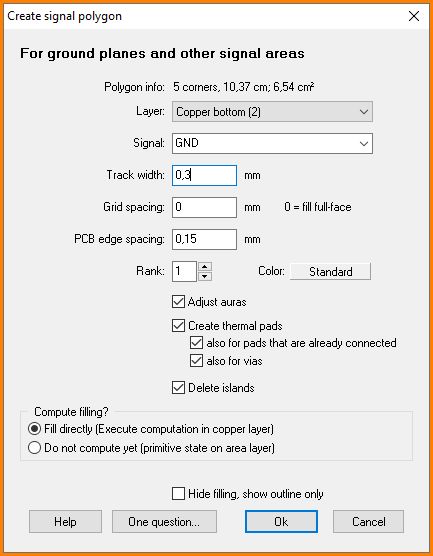
The dialog for signal polygon edition
Layer
A polygon with signal assignment can only be created on a copper layer. The copper layers used in your project can be selected from the drop down list. Select the copper layer upon which your polygon later shall appear (copper bottom, copper top, copper inside).
Signal
Select the signal to be assigned to the polygon. At this point you can only assign one signal to one polygon. Creating a Star shaped ground is a separate topic. Please have a look there.
Track width
In easy words track width is the thickness of the pen which you use to fill the polygon with color. Sounds a bit childish but in respect to the production technique it is the best way to compare. In Gerber a photo pen follows the lines on a photosensitive board with an aperture according to the track width. The sharper the tip of the pen, the more filigree structures can be built. Discuss the smallest value with your PCB-house. Here in Europe the minimum value of 0.15 mm is common.
The following picture shows the polygon with a little notch see arrow. The reason is a track width set too wide. The pen can not go through this bottle neck.
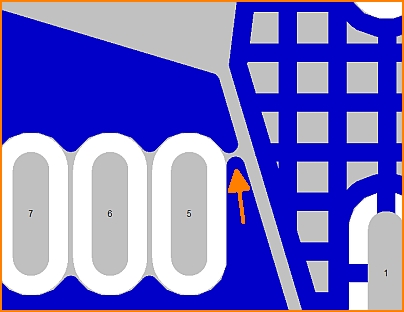
Track width too big to close the area at this spot.
Referring to the track width set here the DesignRuleCheck later checks whether the minimum track width od a connection is fulfilled. The track width must also be seen in combination with the "Grid spacing". A gridded ground plane in consists of a net-structure made of orthogonal intersecting lines. The width of this lines you also define here. You can only enter one value for the track width here. The net structure (= ground plane in lines) always has a square mesh structure.
Grid spacing
A ground plane in lines offers production advantages in galvanization and also is preferable in respect to electromagnetic performance of the signal. In addition to the track width you can define the distance of the mesh, the grid spacing. NOTE: If the grid spacing gets too wide, the polygon will not be able to convey the signal any more.
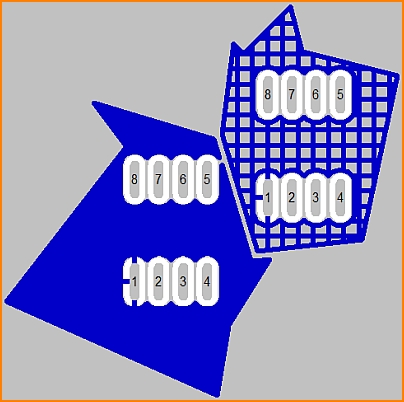
Copper top: Ground plane in lines (to the right). Track width: 0.3mm, Grid spacing: 0.5mm
The limit is:
Grid spacing > Minimum Drill hole diameter + 2 x Width of the rest copper concerning pads
If you use the "Check project" routine or if you "Compute Air Wires (Ratsnest)" such a widely spaced polygon grid can not convey the signal which should run through it. So there will remain an air wire and the soldering pads in question need to be connected by a signal track manually.
The following message could appear when using the "Check project routine"
"Signal-Polygon too chunky: GND on layer 2..."
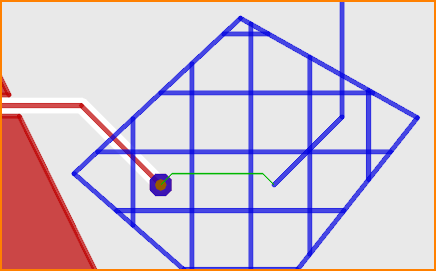
Copper top: The ground plane is gridded too wide. Please use a smaller grid.
PCB edge spacing
It is helpful to have a little spacing between ground plane and cutting edge of the PCB. It can avoid a short circuit by just touching the board by any other object. Also a crosstalk of the signal can be avoided. Define here how far you put back the edge of the ground plane from the edge of the board. Cutting edge of the board is middle of the PCB outline.
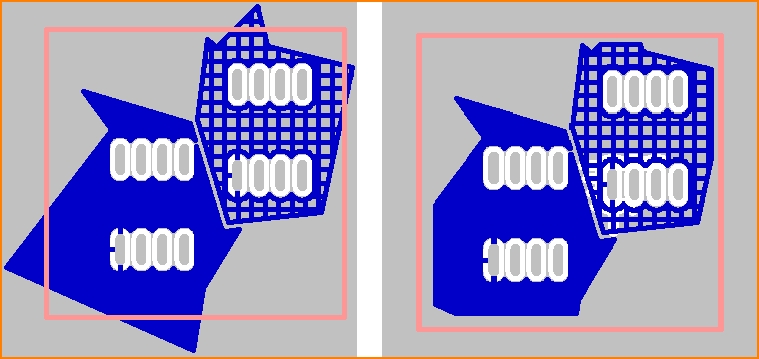
Distance to the edge: left without, right with "stand back" from the edge of the board. In the image to the right the left polygon shows a PCB edge spacing of 0.8mm, the one right beside shows a spacing to the edge of 0.4mm.
Rank
Polygons can overlap, they even can interlace - sure they never should touch each other. Which of the polygons should dominate the other (taking away some of the others shape) can be defined by its rank. The higher the cipher of the rank of a polygon is, the more dominant it is. A polygon with rank 2 dominates a polygon having only rank 1. This means the one with rank 2 takes away the overlapping from the one with rank 1 and so on. There are 99 ranks possible.
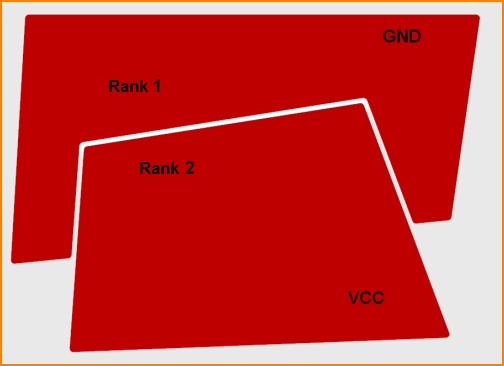
Copper bottom: Interlacing polygons with different signals and different ranks.
The distance between the two surfaces is determined by the value of the "Spacing between single signals", see default entry in the "Check project" dialog. Unless the individual entry for the "Minimum track spacing" of one of the signals (or their signal classes) would be set larger. Then this value would be used. So the higher value of both will be used to determine the gap.
Adjust auras
If you create a signal polygon new, the auras of the tracks, vias and pads touching the polygon or being inside the polygon will be adapted. If you later edit the auras manually, they will not be adjusted automatically when you refill the polygon unless you check the "Adjust auras" box. The following will happen:
- a different-signal pad/via gets isolated
- a same-signal pad gets a thermal
- a same-signal via will be completely embedded to the plane
Afterwards you can manually change the auras of the individual soldering pads and vias. TARGET will not propose to adjust the auras when recalculating the polygon. If you want to embed a pad completely, you can set its aura to zero later or use the field "No aura for these layers:" and list the corresponding copper layer(s). Then let the area (s) be refilled, i. e. the dialog "Edit signal polygon" needs to be opened again and the option "Fill directly (Execute computation in copper layer)" needs to be ticked. Vias never get automatic heat sinks. In general vias are always connected over their entire surface (= embedded). If the user later adds an aura to the via on the ground plane layer, it remains isolated in this ground plane, i. e. unconnected.
Create thermal pads
The soldering pad of a component lead having the same signal as the ground polygon, e. g. GND, should be fully embedded in order to connect as best as possible. However, too much heat would dissipate into the ground plane too quickly during soldering, so that the solder agens would not bond well with the copper. Better create a thermal pad. A thermal pad (heat sink, thermal) is a soldering pad which is surrounded by a safety distance (aura) but connected to the ground plane by small bars only. This prevents the heat energy from dissipating too quickly into the plane when soldering. These automatic bars are cross-shaped to the pad. Also see Thermal Pads.
The sub option "already connected pads too" assigns preferably 4 thermal bars also to those soldering pads which already had been connected manually or by the auto router.
The width of these automatic bars is:
- at least as wide as the line width of the polygon
- maximally double the width of the polygon's line width
- maximally as wide as the half of the smaller side of the pad (pad hight, pad width)
If the line width of the polygon filling is wider than half the width of the narrow side of the pad, there may also be ligaments causing error messages regarding the minimum width. You can either ignore these errors or connect the pad over its entire surface. Polygonal pads are not automatically connected by ligaments (=not automatically made thermals).
Why do those ligaments in thermal pads lead into empty space sometimes?
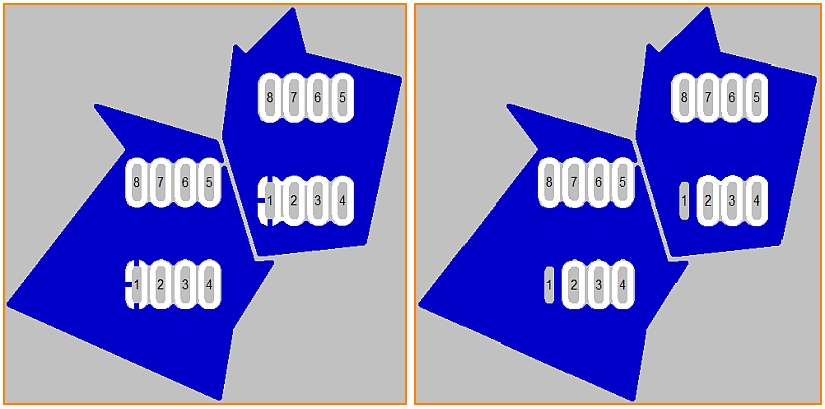
The pads numbered 1 of the two components being located to two polygons. Left with thermal pads, right without - thus embedded completely to the plane.
Delete islands
A not connected piece of a signal polygon is called "island" or "orphan". They dont have any purpose and often make trouble. So they should be removed. TARGET does this automatically if you tick the box. A ground plane gets connected by a pad of a component, a via having an aura of 0 upon this layer or a piece of track running through the polygon plane and having aura =0. Always the signal name (the signal) must be identical.
Compute filling
Filling here means something like "copper pour". It is when you merge the signal track structures and the ground area on the copper layer. TARGET then renders the complete structure of "Copper top" or "Copper bottom" (or "Copper inside" if you have) including the ground plane. You can do it instantly ("Fill directly") by confirming the dialog or you can leave the construction in an intermediate state ("Do not compute yet") so that the signal polygon of the ground plane is defined like a primitive. It is kept in waiting position to be handled separately on the "Area"-layer. So the ground plane still can be adapted, moved and trated as you please.
Fill directly (Execute computation in copper layer)
The polygon immediately gets created wit all interactions to all other elements upon the copper layer. It is displayed the way ist will be produced at the end. Any change in design requires the complete computation (rendering). This process can take some seconds in bigger projects. Therefore it might be better to use the option: "Do not compute yet (primitive state on area layer)" see below.
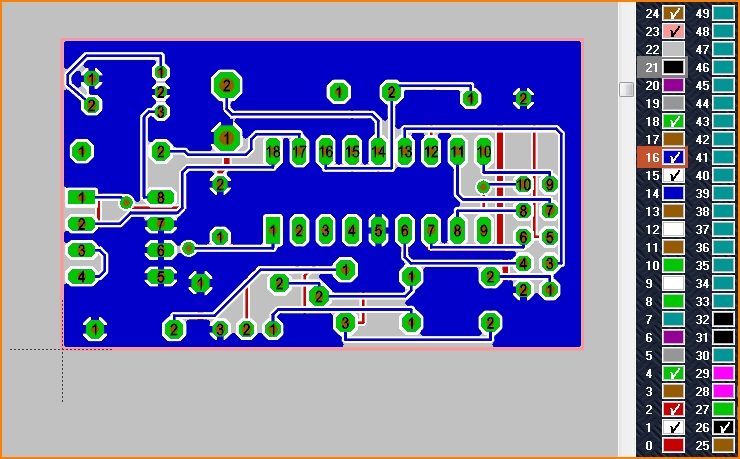
Image: Example of a double sided Layout, ground plane on copper top, filled directly.
Do not compute yet (primitive state on area layer)
If you select this item, the ground plane at first is built up three-layered:
- Its shape on layer "Area", it is the primitive of the ground plane
- The auras of all signals on layer "Deletion", i. e. the spacings of all signals giving clearance to the ground potential (s).
- The tracks on layer "Copper". All signal tracks including the ground signal (s) are displayed here.
Example:
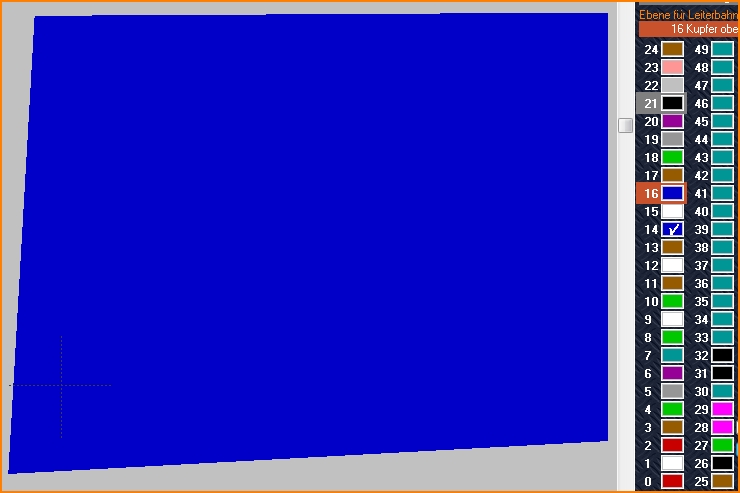
Image: The ground plane as a priitive created by keyboard key [6] Draw signal polygon. It is displayed on layer "14, Area top".
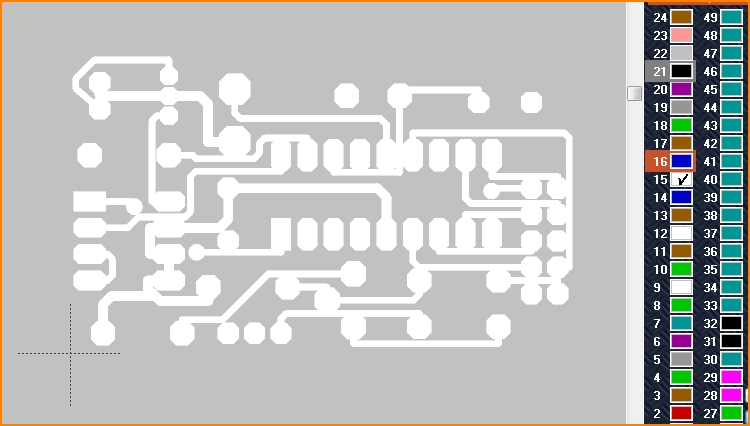
Image: The aura of each of the signals is displayed on layer "15, Deletion top".

Image: DThe copper tracks on layer "16, Copper top"
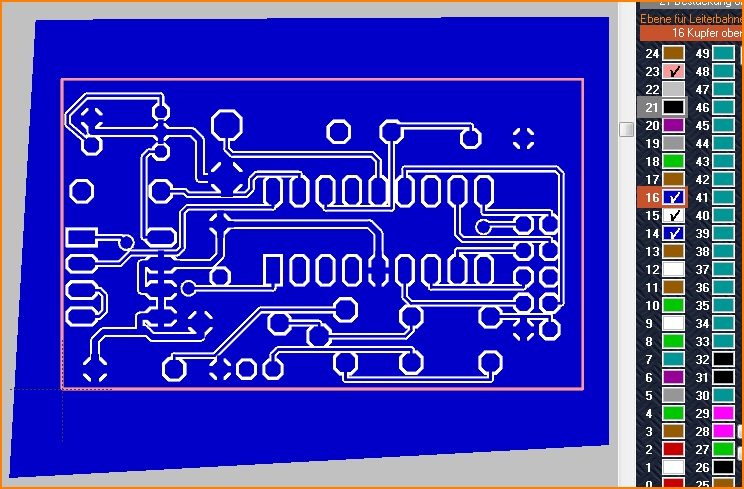
Image: All three layers Copper, Deletion and Area are faded in, in addition layer "23, PCB Outline" (light red). The state still is "Not yet computed", because the three layers are still separate which means not yet "poured into copper". Ticking the boxes to the right each fades them in, unticking fades them out.
Hide filling, show outline only
This is for a better overview and easier grip of elements within the ground plane.
Create a keep out
A keep out is an "area within the area" free from copper. Draw it in any shape (rectangle, circle, polygon) to the deletion layer of the copper side in question before the "Fill directly" command is executed.
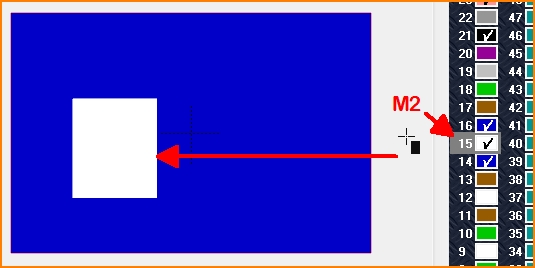
Image: Draw a keep out to the deletion layer: select drawing mode, right click (M2) to the desired layer, begin drawing. (alias keepout, keep-out)
Use the entire PCB area

Image: Use the entire PCB area for a ground plane
Retrieve a groundplane not rendered
You retrieve an already computed filled ground plane (i. e. separate it again to the three planes copper, deletion and area) by selecting the entry "Un-fill all polygons" in the menu Actions at Ground planes. Now you can again show and hide the ground plane separately.
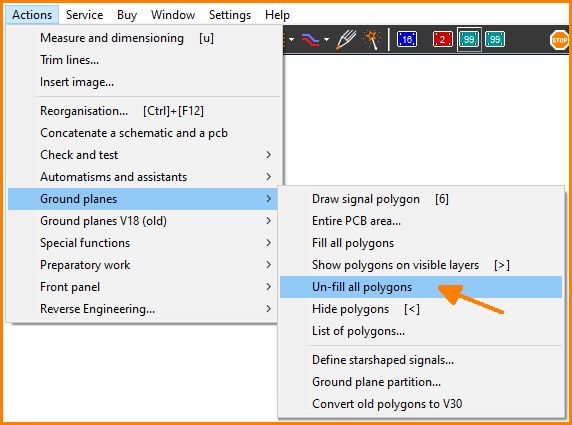
Image: Retrieve ground plane to a triple of layers
Delete groundplane
Highlight groundplane by mouseclick M1 and delete it by pressing the [Del] key.
alias: freehand groundplane, customized ground, copper pour, copper fill


